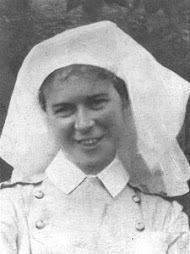Adruenna (“Addie”) Tupper came by her sense of adventure honestly. Her father was Capt. Rufus Trefry, a ship’s captain, part of an extended family of mariners. Her mother was Mary Trefry (née Raymond). Addie was born in 1860 in Yarmouth, Nova Scotia (not 1870, as she would one day write on her attestation papers). She had two younger sisters—Fanny and Jessie, and a twin sister named Mary.
The girls lived at home longer than was fashionable in an age when most women married in their late teens or early twenties. At thirty-one Addie was still living with her parents and working as a music teacher, but by 1901 she and her sisters had finally left home and her father was working as a freight agent for the NSCR at Bridgewater (according to the 1897 McAlpine’s Nova Scotia Directory).
In her early years, Addie attended the Ladies Seminary at what is now Acadia University in Yarmouth, Nova Scotia. She did not graduate and there is no record of her presence there, save for a reference in Robbins Elliott's book Those Waiting Dreams. On page 51, he lists her as: “Adrienna [sic] Allen Tupper, Graduate of Acadia Seminary. She was an Associate of the British Red Cross, and is presumed to have died while serving in England or France.” Unfortunately, Robbins did not say when she graduated and he did not leave the reference among the papers he donated to the university. Addie’s name is inscribed in a monument to former students of Acadia who gave their lives during the First World War.
Sometime in the 1890s, Addie pursued her nursing studies. According to the blog sight “Hayes People,” she attended the nursing school at the General Hospital in Concord, New Haven, Connecticut. (I am currently attempting to locate any records of her that may exist at the hospital. If I find them, I will update this story later on this blog.) Sometime after graduation, Addie seems to have married and may have moved to Boston. In the 1904 Boston directory there is an entry for an Addie Tupper, nurse. The entry is repeated in 1906 with a “Mrs.” Addie Tupper, nurse, listed at the same address. Since no “Mr. Tupper” listed, it is likely that her husband died sometime early in their marriage.
When war was declared in 1914, Addie Tupper was 54 years old. She was 5’ 4” tall, with dark brown hair, and brown eyes. On September 24 of that same year, she enlisted in the CAM . She gave her birth date as 1870, not 1860. This was likely due to the fact that she would have been rejected for service if she had given her true age. Her attestation papers indicate that she was appointed to the CAMC by the Matron-in-Chief (also Nova Scotia-born) Margaret Macdonald.
Addie was in the first contingent of Canadian nurses to serve during the war. The nurses set sail for England on the HMT Franconia. Two hospitals were on that ship—Numbers 1 and 2 General. Addie was part of No. 2 General Hospital. It was to be stationed at Le Treport, France, a small fishing port and seaside resort situated in the Pays de Caux, about 21 miles (34 km) northeast of Dieppe. However, when the nurses arrived overseas, their hospital was not yet ready to receive them. While they waited, they served in various British hospitals. Addie served in an officers’ hospital in Ablington House, in the Wiltshire village of Figheldean. According to British History online (http://www.british-history.ac.uk/report.aspx?compid=115431), it was a typical country mansion that—like many—had been temporarily put into use as a military hospital. The house had been built in the early 19th century, and was a two-storeyed L-shaped house of brick with a hipped slated roof. Its north-west entrance front had five bays, the central one of which projected, was surmounted by a pediment, and had a stone porch. It was here that Addie worked and waited. Finally, in April 1915, she and the other nurses—scattered in hospitals around Britain—were given orders to embark for Le Treport.
According to the blog http://throughtheselines.com.au/research/le-treport :“During the First World War, Le Treport was an important hospital centre. No.3 General Hospital was established there in November 1914, No.16 General Hospital in February 1915, No.2 Canadian General Hospital in March 1915, No.3 Convalescent Depot in June 1915 and Lady Murray’s B.R.C.S. Hospital in July 1916. These hospitals contained nearly 10,000 beds. No.47 General Hospital arrived in March 1917 and later that year, a divisional rest camp and a tank training depot were established in the neighbourhood.”
The Matron at No. 2 General was E.C. Rayside. Her war diary charted the busy life of the military hospital. The hospital was a busy one; the hospital had beds for 1,040 patients. The Matron’s diary has a steady record of hundreds of wounded coming in at a time, and evacuations of hundreds of patients to England. There were, of course, brief lulls in the work, with Princess Victoria’s Concert Troop entertaining staff and wounded alike, or trips to town for the nurses on their occasional afternoons off.
In August 1915, Addie became ill with “neuritis” and was on medical leave for one month. She had severe pain in her left leg due to “exposure to wet and cold.”
In November 1915, Addie was on the hospital troop ship Metagama, accompanying convalescing soldiers on their way home from England. She returned to England on the 14th of December aboard the Corsican. It was likely a welcome break from her heavy nursing work in France.
After her return, Addie served at the Granville Support Hospital in Ramsgate for four months before returning once again to France. Here the Matron’s War Diary mentions her again on April 8, 1916. “Bright and cool, Sisters Tupper and Andrew reported here for duty from England.” Their arrival was timely, many new gas cases were coming into the hospital and many hands were needed.
It was a stressful time at the hospital. In May, the Matron reported that great “restrictions are being made with hospital diets all the time, we Canadians find this very hard.” The nurses were being inoculated again (the Matron does not say what they are being inoculated against) as so many of them were becoming sick. A convoy of 324 wounded arrived with “a great many serious cases,” according to the Matron. At the end of May 1916, more wounded flood in and she writes that the men “tell distressing stories of a very heavy bombardments then an advance by the Germans.”
On June 4, 1916, Addie and the previously mentioned Nurse Andrew were formally recognized for their hard work. “Sisters Tupper and Andrew at present with this unit were awarded the Royal Red Cross.” It was the highest honour for nurses and Addie would write home to describe receiving the award. According to genealogist George Newbury, some years ago he came across a letter in a Nova Scotia archive, in which Addie Tupper described receiving her award. However, he does not recall which archive. If any readers of Finding the 47 know of this letter, please let me know and I will publish the details in a future blog.
Summer brought some respite for the hardworking nurses of Le Treport. There were occasional baseball games to watch, picnics to enjoy.
In November 1916, Addie was once again transferred to England to serve at Hillingdon Convalescent Hospital in Uxbridge, Bexhill. The hospital, according to its war diary had many deficiencies. Despite many requests to military authorities, it had two few stoves, was cold and drafty. Lighting was poor—many wards lit by candles. It was here that Addie Tupper would move from being a nurse to being a patient. In December, she became dangerously ill with pneumonia. She died December 9, 1916 and is buried in the Hillingdon and Uxbridge Cemetery, England.
Wednesday, April 10, 2013
Remembering Addie Tupper, a "Royal" Nurse
Subscribe to:
Post Comments (Atom)






















No comments:
Post a Comment